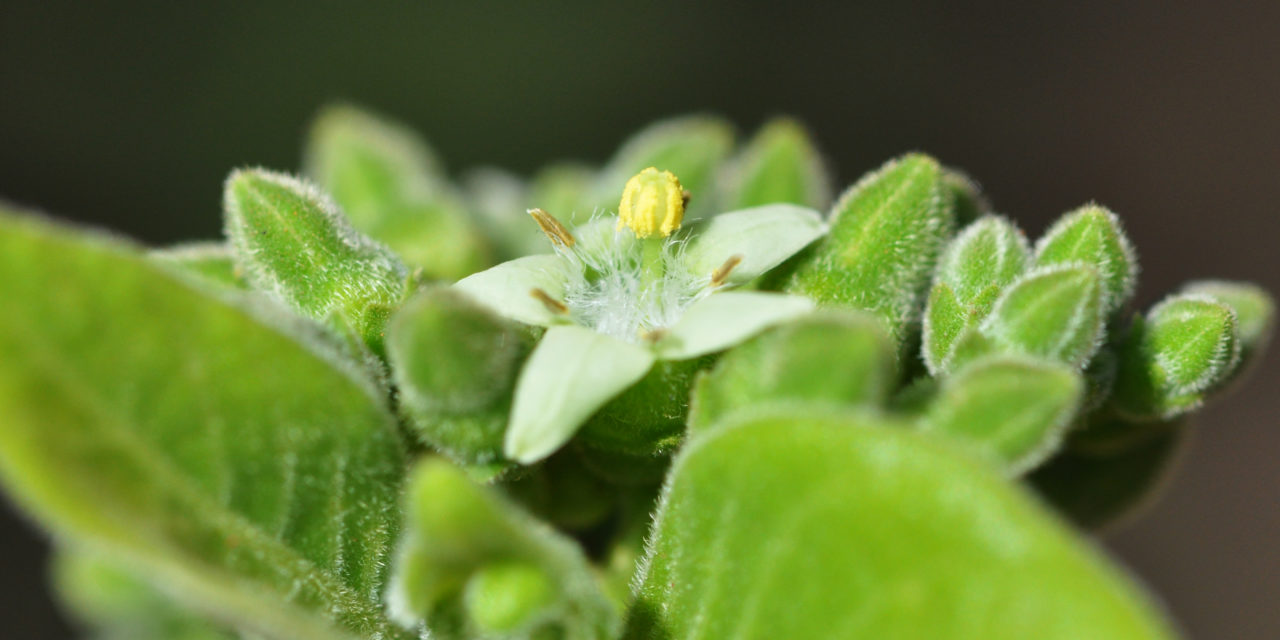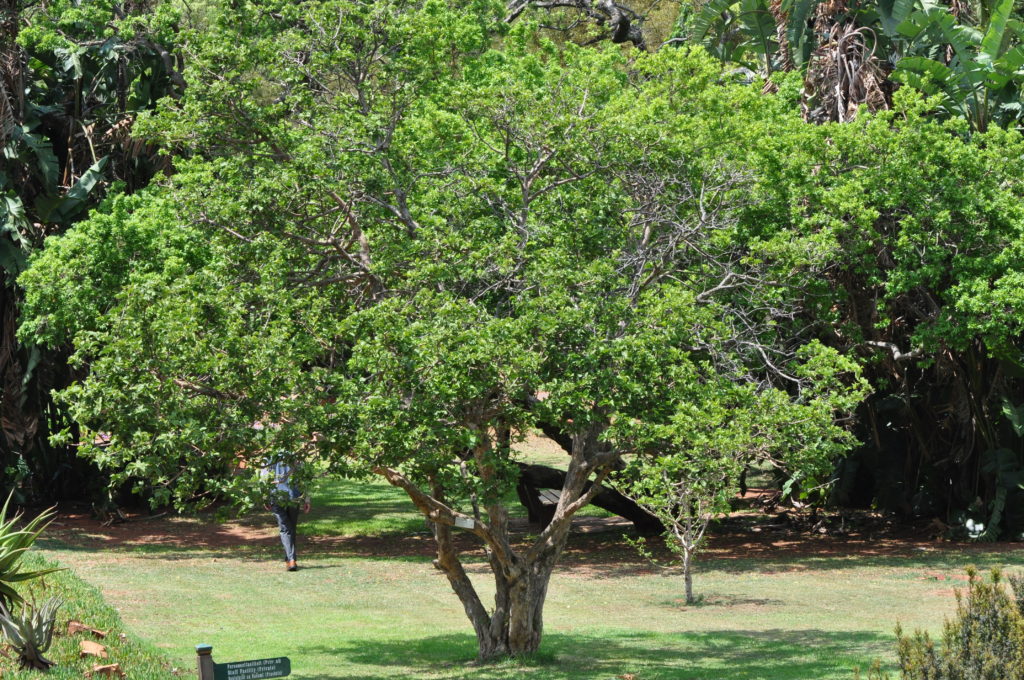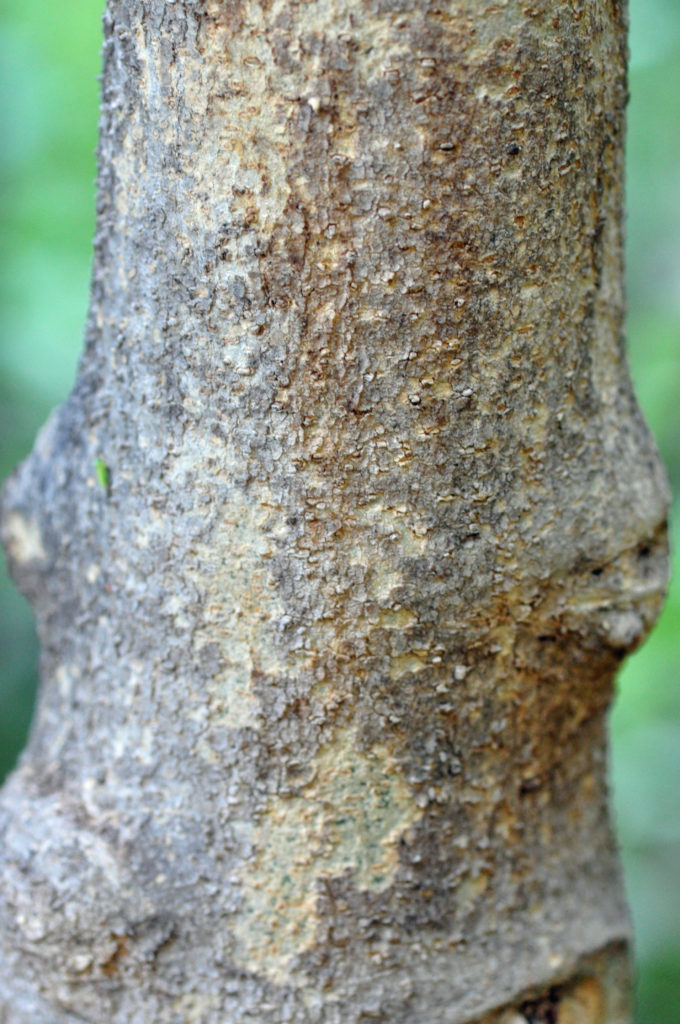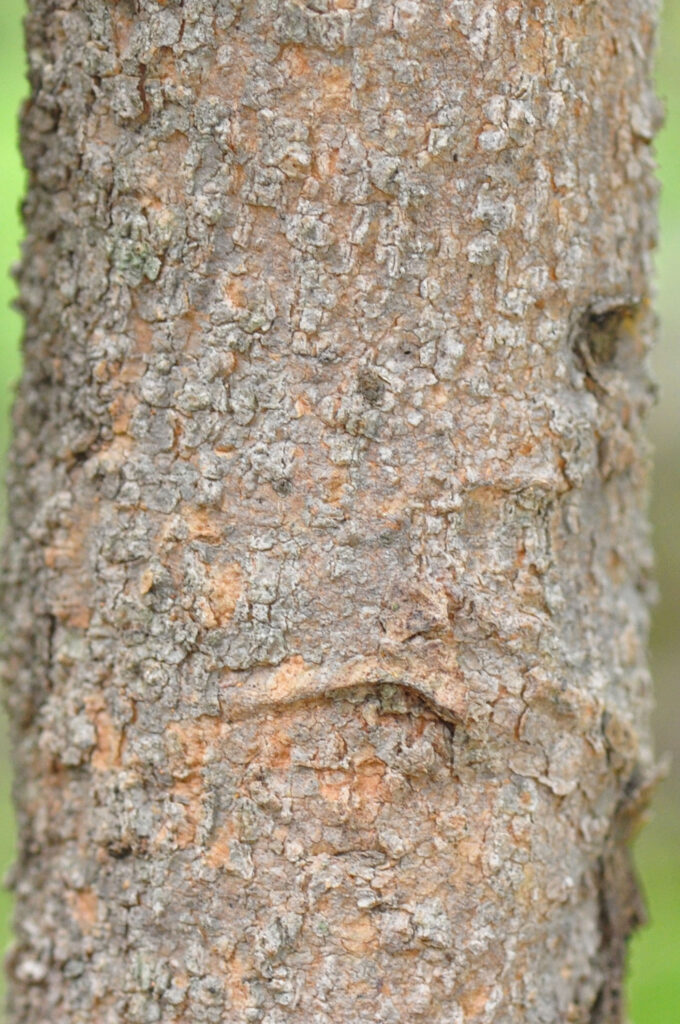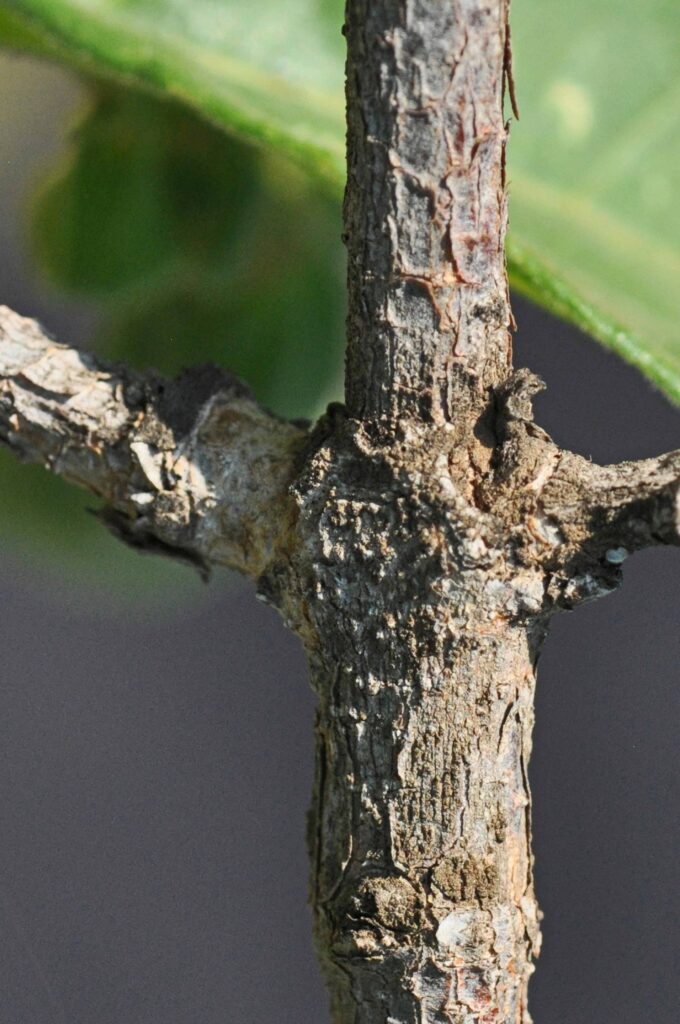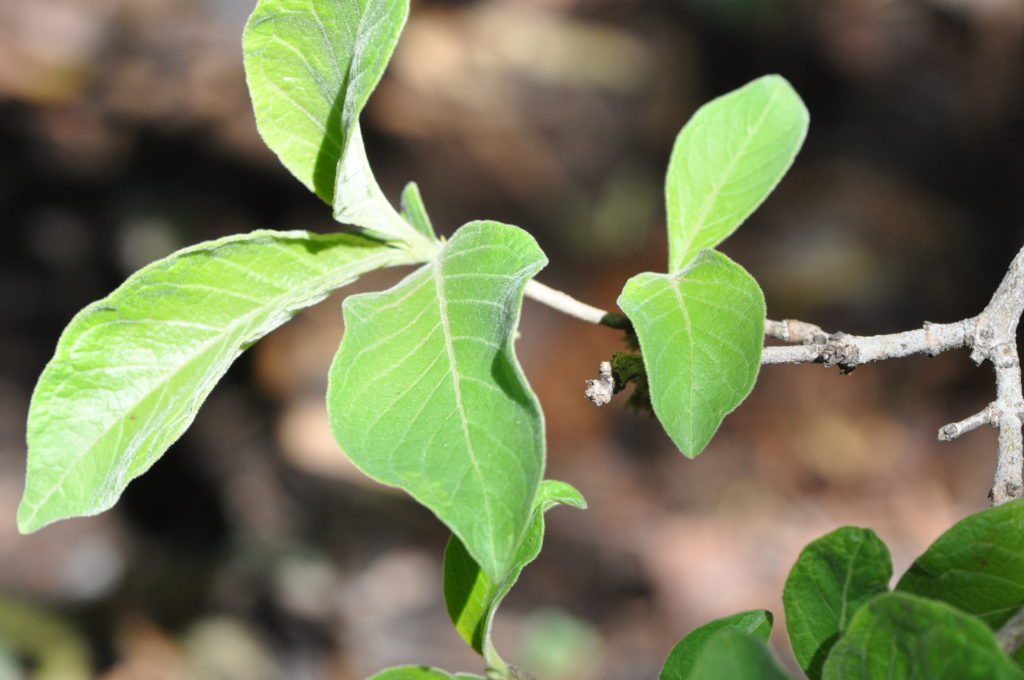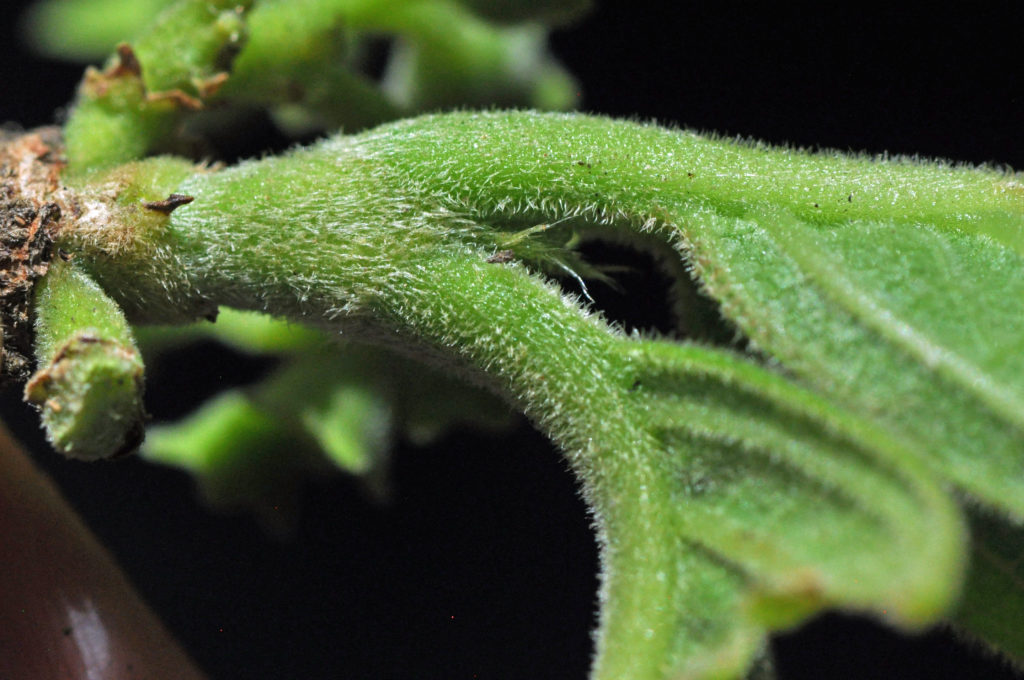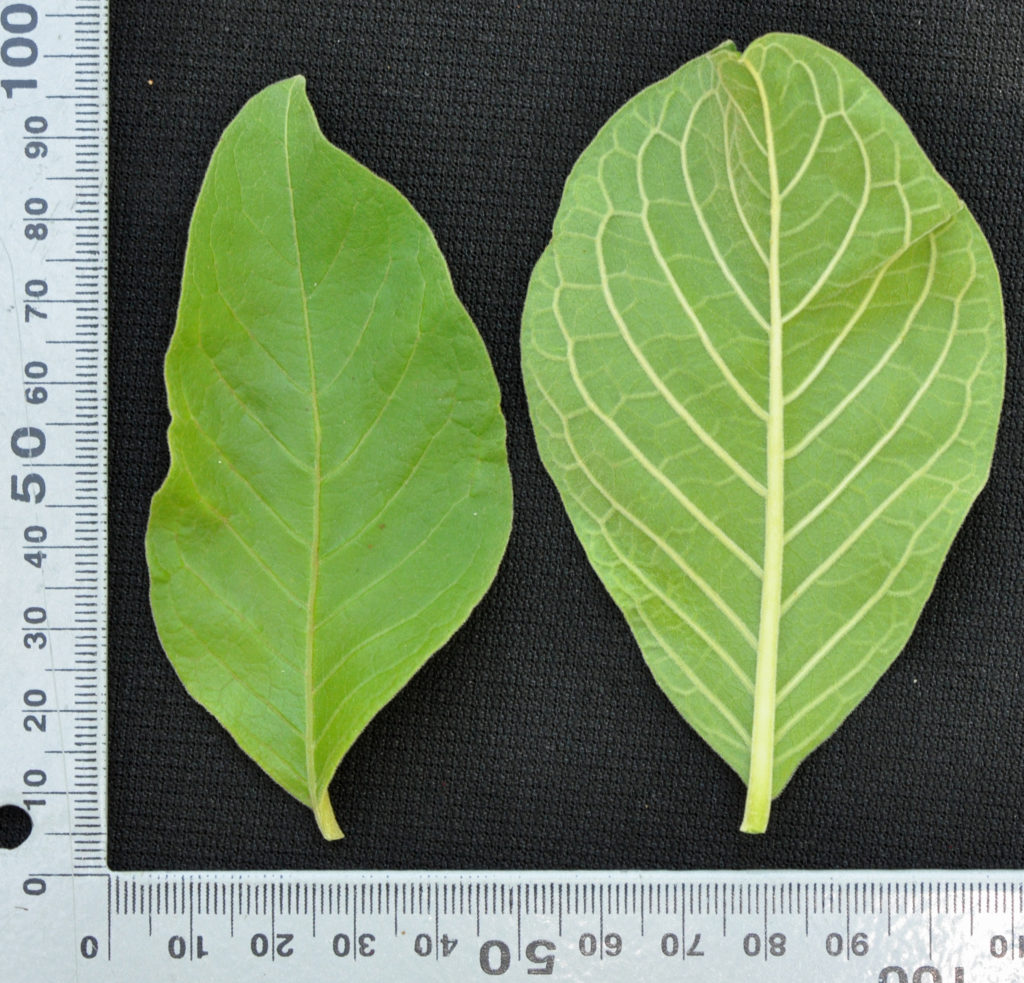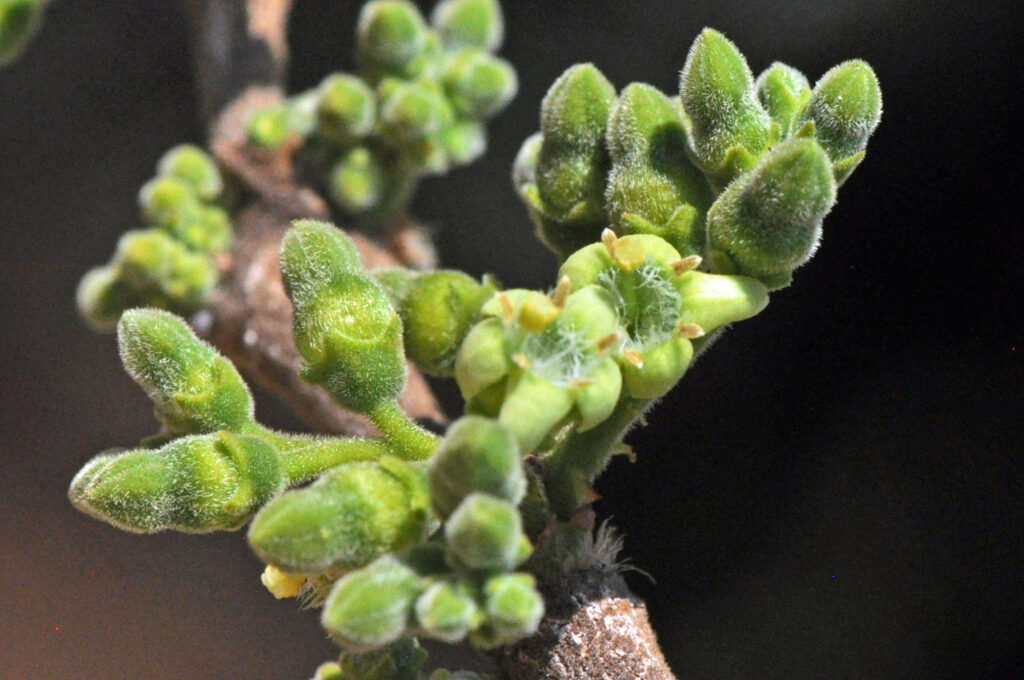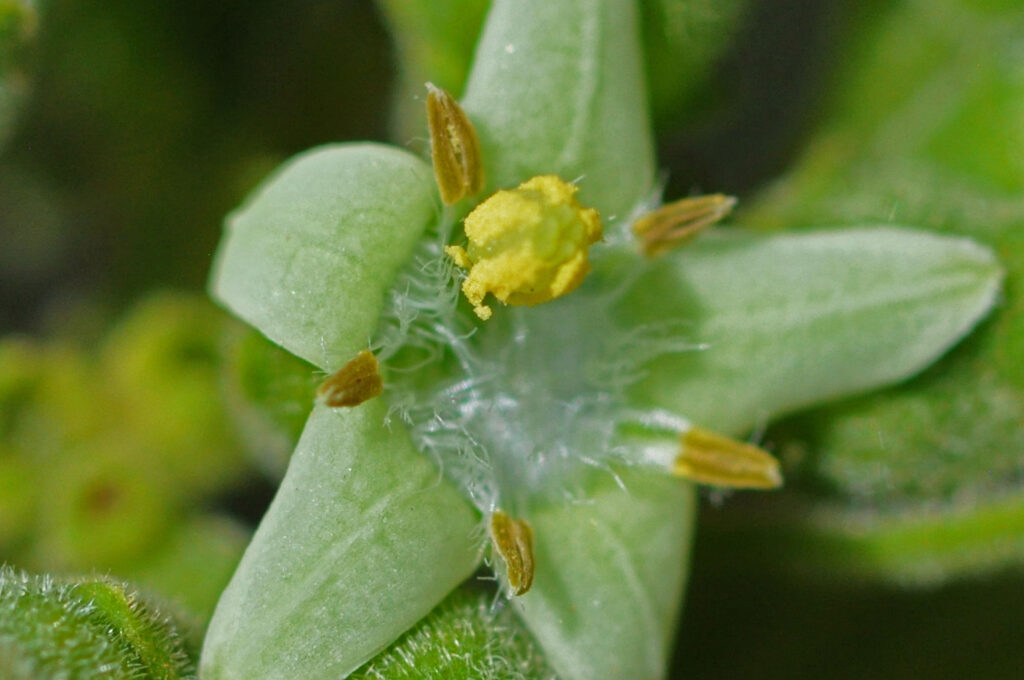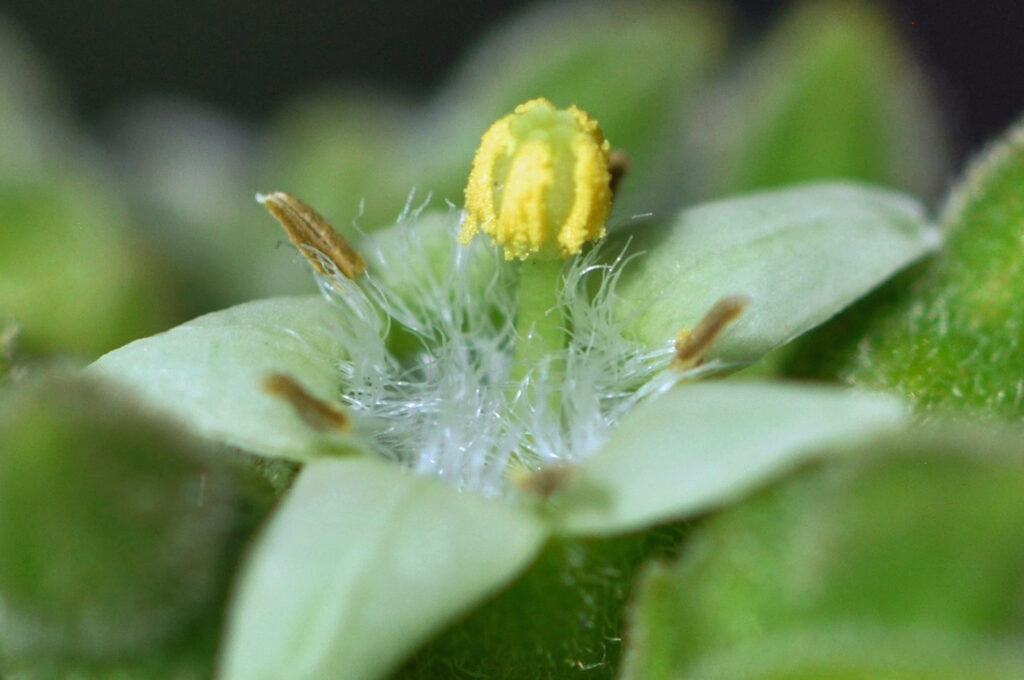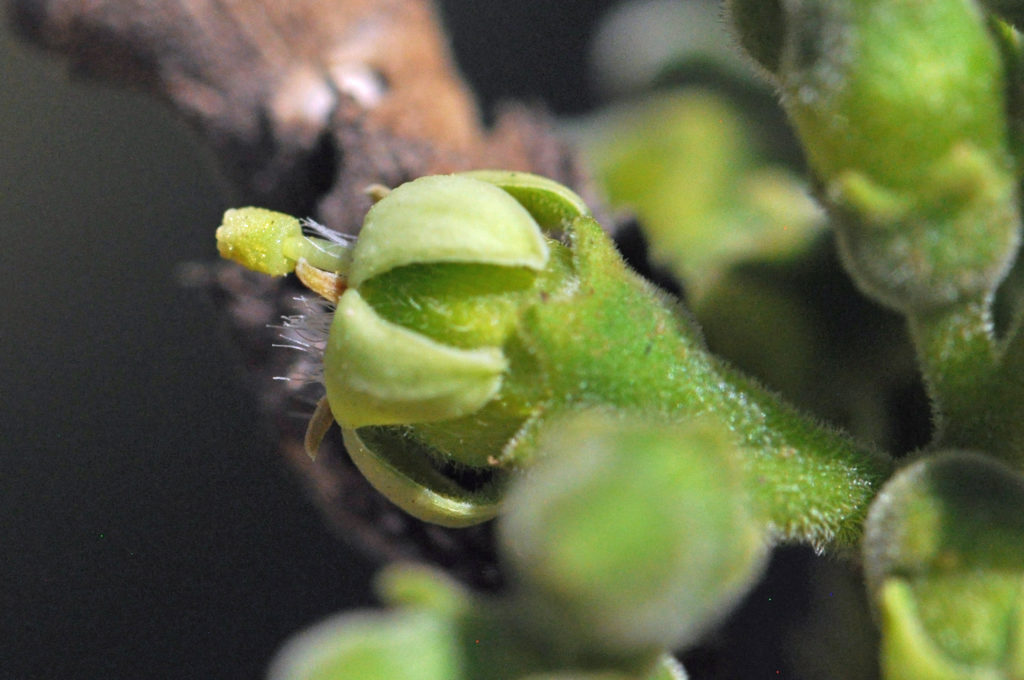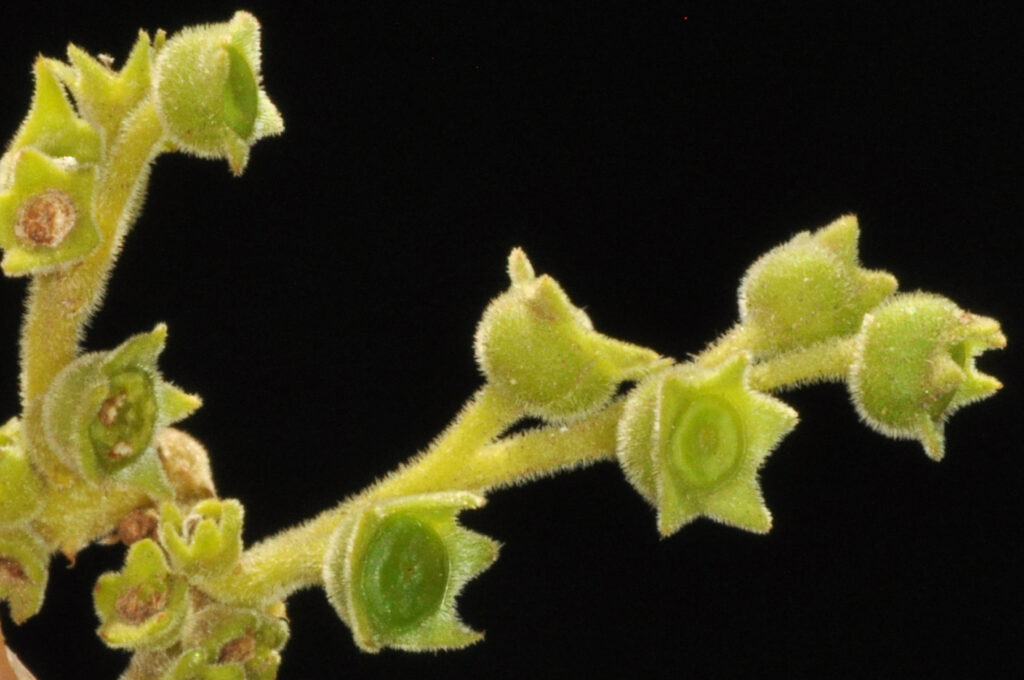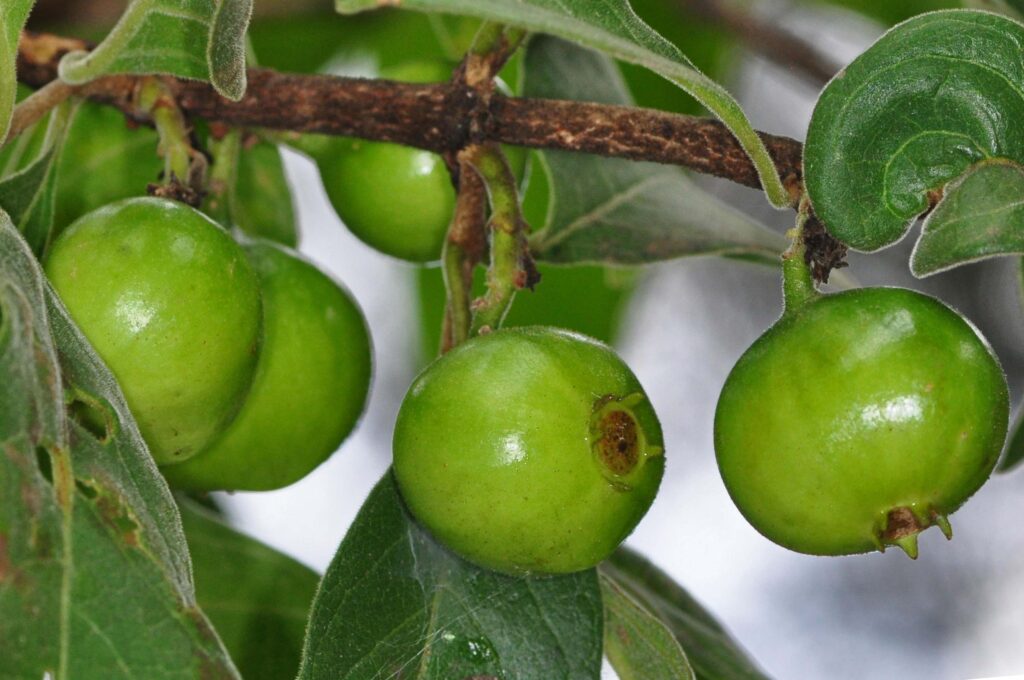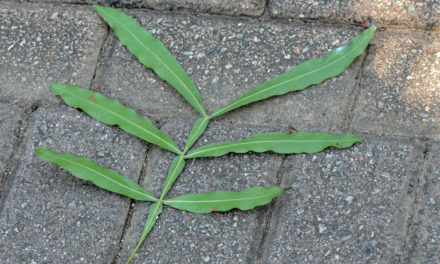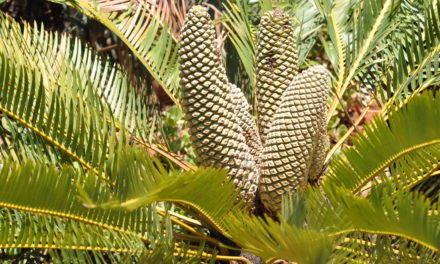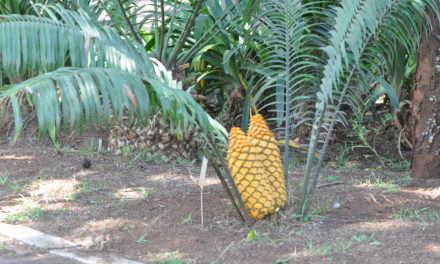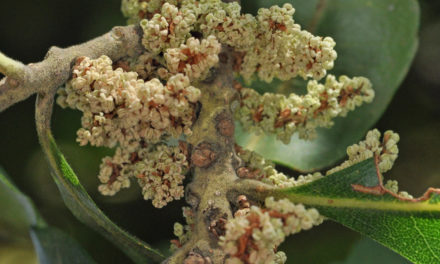General Info – summary
This sparsely crowned Tree with its thick, rough bark may reach 9m high or it may remain a shrub. Large, opposite, hairy, simple Leaves are entire. The 5-merous, bisexual, regular Flowers are in cymes & up to 0,6cm wide cymes. The ovary is inferior & both the stamens & the single swollen stigma extend just beyond the corolla mouth. The nutritious sought after Fruit is a 5cm wide drupe usually containing 3 large seeds.
Description
Vangueria infausta subsp. infausta
Previous Names: Vangueria munjiro, Vangueria tomentose, Vangueria velutina.
SA Tree No. 702.
Common names: (Afr) Mispel, Grootmispel, Wildemispel. (Eng) African Medlar, Velvet Wild-medlar, Wild-medlar. (isiXhosa) Umbizo. Umvilo. (isiZulu) Isantulutshwana, Umtulwa, Umthulwa, Umvili, Umvilo, Umviyo. (Northern Sotho) Mmilo. (Setswana) Mmilo, Mothwanye, Ntswila, Umvivi, Umvlyo. (siSwati) Amantulwane, Imandulu, Umntuli, Umntulwa, Umvile. (Tshivenda) Mavelo, Muzwilu. (Xitsonga) Mpfilwa.
Famly Rubiaceae (Coffee/Gardenia family). This family of dicotyledonous plants has in excess of 600 genera and about 13 000 species and members include trees, shrubs and herbs. Local genera with trees on this website include Afrocanthium, Canthium, Coddia, Gardenia, Pavetta, Rothmannia and Vangueria. Leaves are simple, opposite or whorled and have interpetiolar stipules. Flowers are bisexual or unisexual. The calyx has sepals that are at least partly united. Petals are joined – at least at the base. Stamens are usually as many as and alternating with corolla lobes. The Ovary is inferior. Fruit is a drupe, berry or capsule.
Name derivation: Vangueria – from voa vanguer the Madagascan name for Vangueria edulis. infausta – unlucky – referring to a local belief that burned wood causes mainly male calves to develop. There are 16+ species of the genus Vangueria in South Africa.
Conservation: National Status: L C. (Least Concern). Assessment: 2005 (W. Foden and L. Potter).
Tree
With its sparse crown (photo 419), the single Tree may reach 8m high (usually shorter). It can also be a multi-stemmed shrub. The crown is sparse, and the young Trunk is initially smooth and grey (photo 828) but the Bark becomes thick, rough, and knobbly ribbed and peals with age. Pinkish under-bark may be visible (photo 843). The tree branches low down (photo 419). The small stout thick branches and may appear in opposite pairs (photo 873). Short white hairs cover these branches.
- 419 2016.11.15 Pretoria NBG. Photo: David Becking.
- 828 2017.11.14 Pretoria NBG. Photo: David Becking.
- 843 2014.03.25. Walter Sisulu NBG. Photo: David Becking.
- 873 2017.11.14 Pretoria NBG. Photo: David Becking.
Leaves
On this deciduous or semi-deciduous tree, the opposite paired Leaves (photo 525) are lightish green when mature and slightly darker above. These leaves may become large, up to 30 x 18cm (photo 527) or remain small. They are ovate to obovate (like an upside down egg with the narrower end at the base-photo 527), elliptic or roundish and thick. New spring leaves are light green, thick and velvety or hairy (photo 467). The Apex is either round or bluntly pointed (photo 525). The Base is rounded or tapering. The often-wavy Margins (photo 525) are entire (with a continuous margin, not in any way indented). The Blade is densely covered with soft hairs on both sides – especially when young (photo 467). It is medium green above and lighter below – where up to 8 pairs of yellowish lateral veins are extended and clearly visible. Here the midrib distinctly protrudes (photo 527). Stipules (basal appendages of the petiole) are up to 2cm long (photo 467). The opposite pairs of leaves have joined pairs of stipules between them. Each stipule has a broad base and tapers to a hairy point between the 2 leaf petioles (photo 467). The hairy Petiole (leaf stalk) is short – up to 1cm long (photo 527). Stalked galls (abnormal outgrowths of plant tissue caused by parasites like fungi, bacteria mites and insects) may be visible on lower side. The fallen leaves show autumn colours fairly early and in late winter the branches, now devoid of leaves, may become conspicuously grey-white.
- 525 2016.11.15 Pretoria NBG. Photo: David Becking.
- 467 2017.10.17 Pretoria NBG. Photo: David Becking.
- 527 2016.11.15 Pretoria NBG. Photo: David Becking.
Flowers
The bisexual, greenish white to yellowish Flowers are usually about 4mm long by 6mm wide, often develop before or with the new leaves, and are actinomorphic (Regular, symmetrical. Flowers are vertically divisible into similar halves by more than 1 plane passing through the axis). The hairy pointed buds are acorn-shaped (photo 166) and develop in branched heads. In this photo, the Pedicles (stalks of single flowers) are visible. The flowers develop in cymes (broad, more or less flat-topped, determinate flower cluster, with central flowers opening first) and are on bare branches or axillary (growing between stem and leaf) – not in terminal positions. One or more whorls of bracts stand underneath a flower or flower-cluster. The persistent 5-lobed Calyx is green and initially hairy (photo 166). The Corolla has 5 Petals (photo 181) that are yellow or greenish yellow or whitish and are valvate (meet at the edges without overlapping). The mostly recurved petal lobes are acutely tipped (photo 70) and fall early. Many fine white hairs are clustered in the flower throat (photo 180). The 5 Stamens arise in the hairy corolla mouth, alternate with the corolla lobes (photo 181) and extend slightly beyond the mouth. The linear Filaments are shorter than the Anthers. There is a single Pistil (unit of the Gynoecium, the female element of the flower, composed of the Ovary, Style and Stigma). The locular inferior Ovary contains a single ovule in each locule. The single terete (circular in cross-section) Style extends and ends in a single, thickened yellow cylindrical and furrowed Stigma.
A Pollen Presenter, which stores the plants own pollen develops on the Style (in this plant the 5 yellow vertical structures below the stigma – photo 181). Once pollen has been removed by pollinating agents, the Stigma opens for the first time to receive pollen. This procedure helps to prevent self-pollination. (Sep-Nov).
- 166 2017.09.19 Pretoria NBG. Photo: David Becking.
- 181 2017.09.19 Pretoria NBG. Photo: David Becking.
- 180 2017.09.19 Pretoria NBG. Photo: David Becking
- 70 2019.09.12 Pretoria NBG. Photo: David Becking.
Fruit
The large fleshy indehiscent and almost spherical shiny Fruit (photo 442) is a stone fruit or Drupe – an indehiscent fruit in which an outer fleshy part (exocarp, or skin; and mesocarp or flesh) surrounds a single shell (the pit, stone, or pyrene) of hardened endocarp with a single seed inside). The drupe usually develops just below the leaves. Small young drupes are visible in photo 423). The mature drupe has a diameter of up to 5cm, is almost spherical (photo 442) and develops a light blown to orange leathery skin when ripe. The fruit ends with a ring-like mark caused by the persistent remains of the Calyx (photo 442). In this photo, the remains of calyx lobes are still visible on the not yet mature fruit. Usually about 3 large Seeds are contained within fruit and these are surrounded by a pithy sour-sweet dry flesh. (Nov-Apr).
- 423 2016.11.08 Pretoria NBG. Photo: David Becking
- 442 2014.02.25 Walter Sisulu NBG. Photo: David Becking.
Distribution & Ecology
This hardy, drought resistance Plant is common in sandy valleys, dunes, scrub and can withstand moderate cold weather. It is also found on rocky hillsides and wooded grassland-usually above the coast and below 2 000m. The sparsely branched tree allows grass to develop close to the stem. The Flowers attract birds, insects, flies and butterflies. Bushbabies, tortoises and monkeys consume fallen Fruit. Kudu and bushpigs also consume fruit on the tree. Monkeys, bushbabies and game, including kudu consume the Leaves. Smalls protruding insect galls may appear on the leaves. Round bulges, caused by a fungus growth, may be present on the leaf blades. Trees occur in Eastern and Northern Cape including the Kalahari, Free State, KwaZulu-Natal, Gauteng e.g. Melville Koppies, Limpopo, North West and Mpumalanga. Beyond South Africa, they occur in Swaziland, Botswana, Namibia, Angola, Zimbabwe, widespread in Mozambique, Tanzania, Malawi, Uganda and Kenya.
Ethnobotany
The Fruit is light brown when ripe, contains a high vitamin C content and is safe to eat. Children play with the hard green fruit. Fruit is eaten raw, or the pulp soaked and separated from the seeds, mixed with milk or dried. The fruit is used to flavour mealie-meal porridge after first removing the seeds and skins. Fruit pulp mixed with a little sugar and water is a good substitute for applesauce. Brandy can be distilled from the fruit and puddings are often made from it. The hard, green fruits make good tops for children. Many local people will not burn the Wood because they believe that it will cause their cattle to have only male calves. Roots and leaves are used in local medicine. Sticks are used for manufacturing wood-traps. Goats browse the Leaves. Propagation is from cuttings and planted seeds. The seeds should have all pulp removed and be soaked before planting in well-drained, sun-drenched soil. Local medicine makes use of the roots and leaves.
References
Boon, R. 2010. Pooley’s Trees of eastern South Africa. Flora and Fauna Publications Trust, Durban.
Burrows, J.E., Burrows, S.M., Lotter, M.C. & Schmidt, E. 2018. Trees and Shrubs Mozambique. Publishing Print Matters (Pty) Ltd. Noordhoek, Cape Town.
Coates Palgrave, M. 2002. Keith Coates Palgrave Trees of Southern Africa, edn 3. Struik, Cape Town.
Foden, W. & Potter, L. 2005. Vangueria infausta Burch. subsp. infausta. National Assessment: Red List of South African Plants version . Accessed on 2024/03/21.
Lawrence, G. H. M, 1951. Taxonomy of Vascular Plants. The Macmillan Company, New York. Tenth Printing 1965.
Palmer, E. & Pitman, N. 1972. Trees of southern Africa. Balkema, Amsterdam, Cape Town.
Schmidt, S. Lotter, M. & McCleland, W. 2002. Trees and Shrubs of Mpumalanga and the Kruger National Park. Jacana, Johannesburg.
van Wyk, B. & van Wyk, P. 1997 Field guide to Trees of Southern Africa. Struik, Cape Town.
https://en.wikipedia.org/wiki/Vangueria_infausta
http://www.plantzafrica.com/planttuv/vanguarinfaust.htm
http://www.zimbabweflora.co.zw/speciesdata/image-display.php?species_id=155720&imag
http://posa.sanbi.org/flora/browse.php?src=SP
https://en.wikipedia.org/wiki/Rubiaceae.

